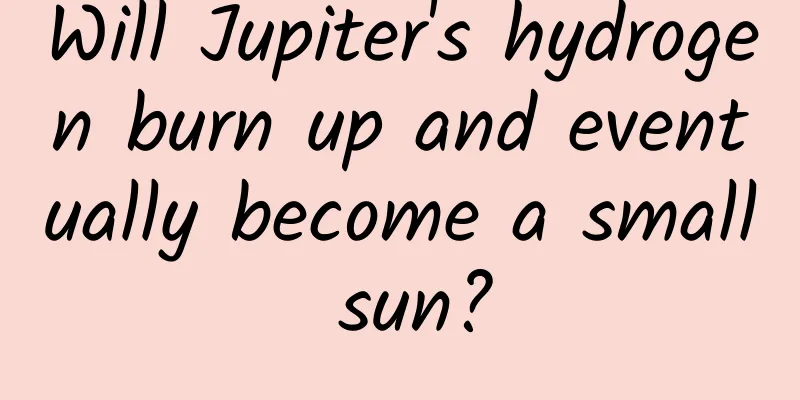Will Jupiter's hydrogen burn up and eventually become a small sun?

|
This topic has been discussed many times. Since friends are still interested in this type of topic, let me talk about it again from a more popular perspective. First of all, let's talk about what the sun is. In fact, the sun is a name given by humans to the only star in our planetary system. By extension, all stars in the universe can also be called the sun. A star is a mass of interstellar gas and dust with a huge mass. Under the influence of the molecules' own gravity, they gradually attract each other and condense together, squeezing tighter and tighter. Due to the imbalance of contraction, they gradually rotate, and the main mass gathers more and more in the core, and a planetary disk is thrown out at the rotating equator. In this way, the smaller the core shrinks, the greater the gravity, and the faster it shrinks, forming a collapse trend. The temperature and pressure suddenly increase, and eventually the high temperature and high pressure of the core drive out and strip off the electrons of the core hydrogen atoms. The exposed atomic nuclei are squeezed together, forming the so-called hydrogen nuclear fusion. The nuclear fusion of stars is the combination of four hydrogen atoms into one helium atom. During the fusion process, there is a mass loss of about 0.7%, which is converted into energy and radiated out, causing this huge mass of gas to burn and become plasma, which continuously emits light and heat, and continuously radiates energy into the vast space. Stars account for more than 99% of the visible mass of the universe, and are therefore the main substance that makes up the universe. In our home galaxy, the Milky Way, there are about 200 to 400 billion stars, and our sun is just an ordinary yellow dwarf among them; and in the entire observable universe, there are about hundreds of billions to 10 trillion galaxies, so there are at least hundreds of trillions of stars. Therefore, it can also be said that there are hundreds of trillions of suns in our foreseeable universe. The light and heat of stars are not ordinary combustion, but the combustion caused by the huge radiation of nuclear fusion. Therefore, there is a basic condition for the formation of stars, which is mass. Only when the mass reaches a considerable level, the temperature and pressure of the core can promote the formation of nuclear fusion. After long-term research by astronomers and modern astrophysics, it was found that in order for a star to become a star, the mass required must be at least 8% of that of the sun, and the core pressure and temperature must be able to ignite nuclear fusion, emit light and heat, and become a sun. Although Jupiter is the largest planet in the solar system and its mass is 2.5 times that of all the planets and asteroids in the solar system combined, in our solar system, the Sun alone accounts for 99.86% of the total mass. The remaining 0.14% mass includes eight major planets, several dwarf planets, hundreds of planetary satellites, countless asteroids and dust debris. Although Jupiter occupies 0.1% of the remaining 0.14% of the mass of the solar system, it is only equivalent to 0.1% of the mass of the sun. To become a star, it needs to have a mass of 80 times the current one, which is 79 times short. Therefore, how can Jupiter become a small sun? Some people always think that Jupiter is mainly composed of hydrogen and helium, and hydrogen is flammable and explosive. If a fire is ignited, wouldn't Jupiter become a small sun? In fact, as I said before, the burning of the sun is not the burning of hydrogen, but the nuclear fusion of hydrogen. Hydrogen cannot burn in any star because it lacks oxygen, a combustion aid. Any combustion cannot be achieved without the assistance of a combustion aid. The most important combustion aid is oxygen. Of course, there are other combustion aids, such as hydrogen and sodium can also burn in chlorine, and magnesium can burn in carbon dioxide. But on Jupiter, there are no such combustion conditions. The visible elements in the universe are mainly composed of hydrogen and helium. According to atomic abundance, hydrogen accounts for about 90% of the entire universe, helium accounts for about 9.7%, and all the other more than 200 elements that have been discovered add up to only about 0.3%. Although oxygen ranks third in the abundance of elements in the universe, it accounts for only 0.085%. As mentioned above, stars are the main celestial bodies with visible mass in the universe, accounting for 99% of the mass, so their main composition is hydrogen and helium. In order for hydrogen to burn, the hydrogen mixture ratio must be between 4% and 75.2% under one atmosphere of pressure. In other words, it cannot burn if the content is greater or less than this value, and it cannot be ignited without an oxidant. No gaseous celestial body in the universe has this condition. Jupiter is a gas giant planet, its composition is about 88% to 92% hydrogen and about 8% to 12% helium by atomic weight, about 75% and 24% by mass respectively. Therefore, on gas planets like Jupiter, not to mention that a match can ignite Jupiter's hydrogen, even an atomic bomb cannot ignite it. The thunderstorms on Jupiter are a thousand times stronger than those on Earth. They bombard Jupiter every day, but they fail to ignite Jupiter. In 1994, a comet named Shoemaker-Levy 9 hit Jupiter. The comet debris split into 21 pieces and bombarded Jupiter's atmosphere like a machine gun. The impact energy was equivalent to 49 trillion tons of TNT, which is about 5,000 times the total number of nuclear bombs on Earth detonating simultaneously, but it did not ignite Jupiter. Therefore, Jupiter will never become a small sun on its own. There is only one possibility for Jupiter to become a small sun, which is to increase its mass by more than 70 times. Even if all the planets in the solar system were merged into Jupiter, it would only increase its mass by 0.4%. Where would this 79 times mass come from? There is only one possibility, which is that when the sun dies in 5 billion years, it will become a red giant and gradually throw about 50% of its mass of external matter into space. That will be the best time for Jupiter to accrete. When the gas, dust and other materials thrown by the sun fall into Jupiter's orbit, Jupiter can absorb these materials into itself. It only needs to absorb about 16% of the materials thrown by the sun to become a smallest star - a red dwarf. However, this possibility is very small. First, the materials thrown by the sun flow in all directions, and it is difficult for Jupiter to absorb so much; second, as the mass of the sun decreases, the gravity decreases, and all planets may move away from the current orbit, making it more difficult for Jupiter to accrete. So, do some people still have hope that if the sun is destroyed, Jupiter will take on the mass of the sun and take over the responsibility of shining on the earth? This is even more unrealistic. Because the sun will gradually become brighter and hotter in the next billion years, the earth will be destroyed by the rising temperature, and the earth will be uninhabitable by then, and all life will be extinct. If humans cannot escape from the earth before then, or even earlier, they will perish together with the earth's life. Moreover, during the red giant phase of the sun, the earth is likely to be swallowed up by the expanding sun and vaporized, turning into nothing. Even if it is lucky enough not to be vaporized, it will become a scorched or frozen dead star. Will Jupiter, when it becomes a red giant, warm the earth again? This is also impossible. The current distance between Earth and the Sun is about 150 million kilometers, which is in the habitable zone of stars of this mass. If Jupiter becomes a red dwarf, with a mass of only 8 percent of the Sun, its habitable zone planet, that is, one that can preserve liquid water and is suitable for life, would be only a few million kilometers away. The current distance between Earth and Jupiter is between about 630 million and 930 million kilometers, and due to the disintegration of the solar system, the distance between Earth and Jupiter will continue to expand. Therefore, even if Jupiter becomes a red dwarf, it will not be able to shine on the earth and provide warmth to the creatures on earth. Some people think that the earth was once a small sun, which is even more naive. After reading this article, I believe everyone will have their own judgment. So, give up fantasy, focus on the present, and enjoy the sunshine now. What do you think? Welcome to discuss. This is an original article from Space-Time Communication. Please respect the author’s copyright. Thank you for your understanding and support. |
<<: I have a runny nose and tears in spring. Is it a cold or allergic rhinitis?
>>: The "Trisomy" appears? This creature can also dehydrate itself!
Recommend
World Rhino Day | Rhinos are extinct in China, so how can we talk about "telepathy"?
September 22 is World Rhino Day. Rhinoceros, a cr...
Will the 2022 Beijing epidemic end by the end of May? How many days has it been since the epidemic was cleared? Attached is the estimated time for complete zeroing
Since the current round of epidemic broke out in ...
Gaozhou SEO Training: What are the profound connotations of SEO? What should a newbie do when doing SEO?
SEO promotion is to obtain traffic through search...
Why do some people get tanned when exposed to the sun, while others get red?
Reviewer of this article: Zhou Xiaobo, Doctor of ...
6 ways to attract new users to securities apps
With the development of the Internet, traditional...
How about Lanzhou WeChat Mini Program Development Company? Which one is better?
In recent years, with the launch of "Mini Pr...
Why is lotus recognized as the center of summer flowers?
When it comes to the center of summer flowers, th...
A project with great prospects for building a middle-aged emotional station website to make money automatically! What industries have prospects?
When we talk about making money online, it is act...
Microsoft finally admits there are too many junk apps in Windows 8
Microsoft provides a large number of high-quality...
The strongest winter typhoon "Lei" may reach super typhoon level. Can it become the last typhoon to land in my country?
Typhoon Lei, the 22nd typhoon this year, has inte...
Microsoft Office iOS / iPadOS version upgraded to a new design: a lot of rounded UI, light background buttons
[[440046]] On December 13, according to feedback ...
App Promotion: How to Take App Screenshots to Influence Download Conversion Rate?
App screenshots are the most direct way to showca...
New broadband players may disrupt the pricing structure
The broadband market has become less peaceful sin...
Information flow advertising creative optimization guide!
The core of information flow advertising lies in ...









